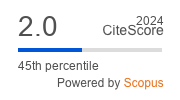Making skills: how courses on digital fabrication enhance 21st centrury skills
DOI:
https://doi.org/10.23726/cij.2024.1463Keywords:
21st-century skills, course design, making, Prototyping, digital fabrication, Challenge-Based Learning, makerspaceAbstract
The paper elaborates on critical "design decisions" of a series of digital fabrication micro-courses offered as an optional addition to the full one- or two-semester programs on engineering design. It presents the results of an evaluation regarding the learning outcomes and 21st-century skills acquired by the students. The evaluation indicates that the courses convey practical making skills and contribute to 21st-century skills like self-efficacy, self-initiative and learning competence. The result of the work can inspire other universities and design factories to set up their device training courses similarly to gain this additional benefit.
References
Bacigalupo, M., Kampylis, P., Punie, Y., & Van den Brande, G. (2016). EntreComp: The entrepreneurship competence framework. Luxembourg: Publication Office of the European Union, 10, 593884.
Byers, T., Seelig, T., Sheppard, S., & Weilerstein, P. (2013). Its role in engineering education. The Bridge, 43(2), 35-40.
Camburn, B., Viswanathan, V., Linsey, J., Anderson, D., Jensen, D., Crawford, R., ... & Wood, K. (2017). Design prototyping methods: state of the art in strategies, techniques, and guidelines. Design Science, 3, e13.
Charosky, Guido, et al. "Challenge based education: an approach to innovation through multidisciplinary teams of students using Design Thinking." 2018 XIII Technologies Applied to Electronics Teaching Conference (TAEE). IEEE, 2018.
Ehlers, Ulf. -D., Kellermann, Sarah A. (2019): Future Skills - The Future of Learning and Higher education. Results of the International Future Skills Delphi Survey. Karlsruhe
Forest, C. R., Moore, R. A., Jariwala, A. S., Fasse, B. B., Linsey, J., Newstetter, W., ... & Quintero, C. (2014). The Invention Studio: A University Maker Space and Culture. Advances in Engineering Education, 4(2), n2.
Galaleldin, M., Bouchard, F., Anis, H., & Lague, C. (2016). The impact of makerspaces on engineering education. Proceedings of the Canadian Engineering Education Association (CEEA).
Kirchner, J., Klier, J., Lehmann-Brauns, C., Winde, M. (2017). Future Skills: Which skills are lacking in Germany. Stifterverband für die Dt. Wissenschaft.
Koh, J. H. L., Chai, C. S., Wong, B., & Hong, H. Y. (2015). Design thinking for education: Conceptions and applications in teaching and learning. Springer.
Kohler, K., Kaiser, P., Dieing, C., Walter, M., Wrobel, D. (2022) „The smaller siblings of ME310 – Commonalities and differences between three courses on interdisciplinary and international user-centric innovation“. 1st Design Factory Global Network Research Conference: Designing the Future. Designing the Future.
Kuckartz, U. (2012). Qualitative Inhaltsanalyse. Methoden. Praxis, Computerunterstützung, 3, 166-169. ISO 690.
Luka, I. (2019). Design thinking in pedagogy: Frameworks and uses. European Journal of Education, 54(4), 499-512.
Organisation for Economic Co-operation and Development (OECD). (2019). OECD future of education and skills 2030: OECD learning compass 2030.
Papageorgiou, K., Hassi, L., Bragós Bardia, R., Charosky Larrieu-Let, G., Leveratto, L., & Ramos Castro, J. J. (2021). Prototyping the future of learning: reflections after seven iterations of Challenge-Based Innovation (2014-2020). CERN IdeaSquare Journal of Experimental Innovation, 5(1), 5-10.
Rajendra, S., & Patil, S. P. K. (2020). Project based learning: an innovative approach for integrating 21st century skills. Journal of Engineering Education Transformations, 33(4).
Rao, V. (2019). Blended Learning: A New Hybrid Teaching Methodology. Online Submission, 3(13).
Ravitz, J., Hixson, N., English, M., & Mergendoller, J. (2012, April). Using project based learning to teach 21st century skills: Findings from a statewide initiative. In American educational research association conference, Vancouver, Canada (Vol. 16).
Shaw, R. L. (2018). Using project-based learning to cultivate 21st century skills in STEM education. ProQuest Dissertations And Theses; Thesis (Ed.D.). Lamar University - Beaumont, 2018.; Publication Number: AAT 13422541; ISBN: 9780438806887 Dissertation Abstracts International, Volume: 80-06(E), Section: A.; 79 p.
Thong, C., Cotoranu, A., Down, A., Kohler, K., & Batista, C. (2021). Design innovation integrating deep technology, societal needs, radical innovation, and future thinking: a case study of the CBI A3 program. CERN IdeaSquare Journal of Experimental Innovation, 5(1), 32-39.
Thoring, K., Mueller, R. M., Luippold, C., Desmet, P., & Badke-Schaub, P. (2018). Co-creating an idea lab: lessons learned from a longitudinal case study. CERN IdeaSquare Journal of Experimental Innovation, 2(1), 30-37.
Tomc, H. G., & Kočevar, T. N. (2020). Observation on creativity and spatial visualisation skills of graphic arts’ students. In Proceedings of the 10th International Symposium on Graphic Engineering and Design.
Trapp, S. (2006). Blended learning concepts-A short overview. In CEUR Workshop Proceedings (Vol. 213, pp. 28-35).
Weinberg, U., Nicolai, C., Hüsam, D., Panayotova, D., & Klooker, M. (2014). The impact of space on innovation teams. In Proceedings of the 19th Academic Design Management Conference (pp. 902-923).
Wiesche, M., Uebernickel, F., Byler, E., Garcia-Cifuentes, J. P., Suzuki, S., Vignoli, M., ... & Krcmar, H. (2018). Teaching innovation in interdisciplinary environments: Toward a design thinking syllabus.
Wilczynski, V. (2015). Academic maker spaces and engineering design. In 2015 ASEE Annual Conference & Exposition (pp. 26-138).
Downloads
Published
How to Cite
License
Copyright (c) 2024 Clara Dieing, Kirstin Kohler, Christian Müller, Manuel Walter, Damian Wrobel

This work is licensed under a Creative Commons Attribution 4.0 International License.
Authors who publish with this journal agree to the following terms:
- Authors retain copyright and grant the journal right of first publication with the work simultaneously licensed under a Creative Commons Attribution License that allows others to share the work with an acknowledgement of the work's authorship and initial publication in this journal.
- Authors are able to enter into separate, additional contractual arrangements for the non-exclusive distribution of the journal's published version of the work (e.g., post it to an institutional repository or publish it in a book), with an acknowledgement of its initial publication in this journal.
- Authors are permitted and encouraged to post their work online (e.g., in institutional repositories or on their website) prior to and during the submission process, as it can lead to productive exchanges, as well as earlier and greater citation of published work (See The Effect of Open Access).


